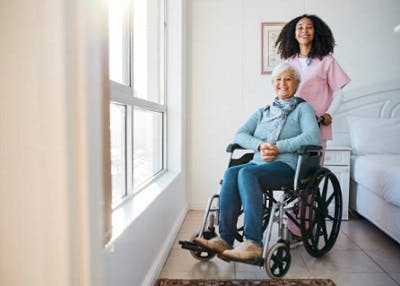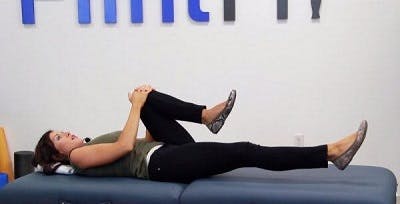Easy Exercises for People With Spine Injuries
When a spinal cord injury disrupts the transmission of signals between the brain and body, completing spinal cord injury exercises can often help restore this communication. Rehab exercises are essential for activating neuroplasticity, which is the central nervous system's ability to rewire itself and strengthen neural pathways.
When searching for spinal cord injury exercises to add to your home therapy regimen, it's essential to find exercises most suitable to your level of ability. This article will discuss the benefits of spinal cord injury exercises and the various types you can use to promote recovery. Be sure to check with your therapist to make sure the exercises are safe for you.
Before diving in, let's first go over the mechanisms behind spinal cord injury recovery.
Benefits of Exercise After Spinal Cord Injury

Every spinal cord injury is different, and the effects survivors may experience also vary. The amount that sensation and muscle movement are affected following a spinal cord injury depends mostly on the level of injury and its severity. The spinal cord is capable of rewiring itself and adapting through the process of neuroplasticity, as long as some connections in the spinal cord remain intact (the injury is not complete).
Neuroplasticity allows existing spared neural pathways in survivors with an incomplete SCI to become stronger and learn new functions. Thus, the more spared neural pathways, the higher the chances of recovery. Of note, although affected functions do not improve with traditional treatments in those with complete spinal cord injuries, some functional recovery using compensatory strategies can still be achieved.
Neuroplasticity is best activated through high repetition exercises, or massed practice. Consistent repetition of weakened movements and stimulation of areas with affected sensation helps to stimulate the spinal cord and promote neurological adaptations. Spinal cord injury exercises also focus on improving mobility by stretching tight muscles, strengthening weakened muscles, and moving the joints through full range of motion.
For instance, survivors may experience spasticity after spinal cord injury, which causes the muscles to tighten up. To help reduce spasticity, individuals can stretch and practice range of motion exercises.
Range of motion exercises are also beneficial for improving blood flow and reducing the risk of pressure sores even if your spinal cord injury is complete. Furthermore, the more you engage in spinal cord injury exercises, the greater your chances of improving mobility.
Spinal cord injury exercises are undoubtedly beneficial, but now you may be wondering, what type of exercises should you practice?
Passive Spinal Cord Injury Exercises
While every spinal cord injury has different functional outcomes, most spinal cord injury survivors can practice passive range of motion exercises.
Passive range of motion exercises do not require the survivor to exert a lot of energy. Instead, a therapist or caregiver moves the survivor's body for them. Individuals who have more control of their movements should try to actively perform range of motion exercises on their own as much as they can.
Passive range of motion exercises challenge you to move your joints through their full range of motion. This helps prevent stiffness and promote circulation in the paralyzed or weakened areas of the body. Try practicing passive range of motion exercises at least once daily to minimize tightness in the joints and stimulate the nervous system.
Here is a video with examples of various SCI passive range of motion exercises you can try with a therapist and/or caregiver. Be mindful of doing these exercises on your own if you are still building up strength to avoid overworking yourself.
Shoulder Flexion
Begin with your arm relaxed at your side. Have a therapist or trained caregiver raise your arm out in front of you, reaching as high as possible without pain. Try to keep your shoulder from shrugging upward and keep the rest of your body aligned. Then your therapist or caregiver can support your arm as it comes back down to your side, and repeat.
Elbow Flexion
Starting with your arm relaxed and your hand facing your side, have a therapist or trained caregiver gently bend your elbow, rotating your forearm so your hand turns toward your shoulder. Bend your elbow as much as possible without pain. Then relax your arm and repeat. This exercise also includes elbow extension, supination, and pronation.
Knee Extension
While sitting, have a therapist or trained caregiver slowly move your leg upwards until your knee is nearly straight. Gently bring your legs back down into your starting position, and repeat. If you are able to actively help with this motion, you should feel the muscles on the front of your thighs engage when doing this exercise.
Ankle Dorsiflexion
Starting in a seated or laying position, have a therapist or trained caregiver raise your toes up toward your calf, then relax back to a neutral position. Again, stop if you feel any pain.
As you begin to recover, try to move through these motions with less help from your therapist or caregiver. If you improve and are able complete these exercises actively but tire quickly, take a break or ask your therapist or caregiver to take over for the remainder of the range of motion exercises. Your endurance should also improve over time with more consistent practice.
Lower Extremity Spinal Cord Injury Exercises
There are various exercises you can do to strengthen the muscles in your legs and improve mobility. Additionally, SCI leg exercises help reduce muscle atrophy, improve circulation, and stimulate adaptive changes in the spinal cord.
However, before engaging in leg exercises for SCI it's important to warm up and stretch. The following video demonstrates various leg stretches you can try using a strap, resistance band, or large towel.
Spinal cord injury can also affect the ability to feel, therefore survivors need to be extra careful and pull gently when stretching to avoid injury.
Once you're warmed up, try these helpful leg exercises for spinal cord injury:
Ankle Pumps
While also laying down, you can point your toes down so that the ankle is extended. Then raise your feet upwards towards the knees to flex the ankles. This exercise mimics the motions the ankles create when walking.
Knees to Chest

Place one hand on the upper leg just above your knee and the opposite foot. Bend one knee in so that it's reaching towards your chest. Then bring your foot down and straighten the knee.
Straight Leg Lifts
Lay down with your legs straightened and lift one leg without bending at the knees. When the leg is as high as it can go, hold for a few seconds. Bring the leg back down and alternate with the other leg. Try to engage your core while doing this exercise to avoid putting undue stress on the lower back.
Seated Marching

Sit at the edge of your seat with both feet on the ground, then alternate lifting your knees one at a time. This leg exercise allows survivors to practice movements used while walking without added pressure on their joints.
Discover more leg exercises for spinal cord injury patients »
Upper Extremity Spinal Cord Injury Exercises
Spinal cord injury survivors with cervical or high thoracic level injuries may often experience weakness in the hands. Fortunately, various hand and arm exercises can help improve fine motor skills and reduce weakness after spinal cord injury.
Here are some upper extremity spinal cord injury exercises you can try:
Arm Circles
For this exercise, put your arms out to the side so that your body makes a "T" shape. Then move your arms in a circular motion going forward and backward. You can alternate between making large circular motions or smaller ones.
Making O's and Fists

Using one or both hands, alternate tapping the tips of each finger to the thumb. After touching each finger, you can also add closing the hand into a fist. Hold a few seconds or as long as you can and straighten the fingers back out.
Wrist Extension
Hold one arm out in front of you with your palm facing down. Then use your other hand to grab the palm and pull it back up.
Separating Fingers
Lay your hand flat on a tabletop or wall. Then practice spreading the fingers apart and bringing them back together.
Music Glove

While these hand therapy exercises may seem simple, they are extremely effective. However, practicing the same movements can get boring and cause you to lose motivation. To help keep you motivated and engaged you can use gamified neurorehabilitation devices.
For example, MusicGlove is a hand therapy device that combines music, gaming, and hand therapy exercises to help you stay engaged and practice high repetitions from the comfort of your own home. MusicGlove has been clinically proven to boost hand function in just 2 weeks!
Discover more hand therapy exercises for spinal cord injury patients »
Spinal Cord Injury Exercises for the Core
Core exercises after spinal cord injury are also essential because they help stabilize the trunk for better balance and posture.
The following video will guide you through some wheelchair-friendly exercises to strengthen the core. Before practicing these exercises, always check that the brakes on your wheelchair are set.
Speak with your therapist before engaging in some of these core exercises if you still have spinal precautions, or have certain movements that need to be avoided after your SCI.
Back Extensor Isometric Hold
Sit at the edge of the seat and lean back against the chair. Hold for a few seconds or as long as you can and use your core muscles to sit up straight again.
Seated Trunk Extension
While sitting in a chair, slowly lean forward as far as you comfortably can and try reaching your hands to the floor. Then, use your back muscles to slowly sit back up. If you have trouble with your sitting balance, be sure to have someone nearby to spot you during this exercise.
Trunk Rotation
Start by laying down and keep your knees bent and feet flat on the floor. Try to keep your shoulders and upper body firmly on the floor. Tighten the abdominal muscles and relax the knees down toward the floor on one side of your body, then the other.
Discover more core strengthening exercises for spinal cord injury patients»
Engaging in Spinal Cord Injury Exercises
The best way to improve mobility after SCI is to consistently practice spinal cord injury exercises. This helps stimulate neuroplasticity in undamaged regions of the spinal cord and strengthen the pathways that control movement.
Every spinal cord injury is different and every survivor will have different functional outcomes so try not to feel discouraged if an exercise is too difficult. A therapist can help you adjust and provide SCI exercises for your level of mobility.
We hope this article has inspired you to engage in spinal cord injury exercises to promote recovery.
Source: https://www.flintrehab.com/spinal-cord-injury-exercises/
0 Response to "Easy Exercises for People With Spine Injuries"
Post a Comment